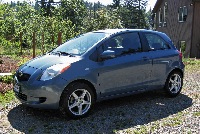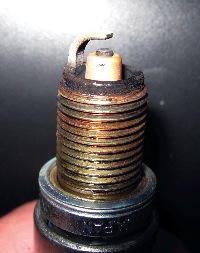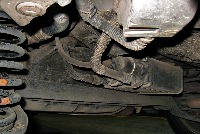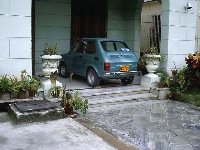 Surprisingly, they both noticed the differences in the vehicles that ply the roads of the “old” country (see Photo 1) and the ones we push around the U.S. They commented on the fact that cars are so much smaller; some can even park facing into the sidewalk in a spot we would use for parallel parking. They also noticed that many, if not most, of the cars and even the mini vans (usually eight-passenger, Citroen, Peugeot, Renault or VW – see Photo 2) were diesel powered and got by on very little fuel. They were still able to go across the landscape fast enough to get pulled over for speeding, while still having space to stretch out and sleep during travel periods.
Surprisingly, they both noticed the differences in the vehicles that ply the roads of the “old” country (see Photo 1) and the ones we push around the U.S. They commented on the fact that cars are so much smaller; some can even park facing into the sidewalk in a spot we would use for parallel parking. They also noticed that many, if not most, of the cars and even the mini vans (usually eight-passenger, Citroen, Peugeot, Renault or VW – see Photo 2) were diesel powered and got by on very little fuel. They were still able to go across the landscape fast enough to get pulled over for speeding, while still having space to stretch out and sleep during travel periods.

The facts are that, at some point, the cost of fuel is going to be a major factor to impact our American driving habits. I’ve owned and driven small European or Japanese 4-cylinder cars for more than 40 years, including VW diesel-powered cars. While the smallest European models are still not available in large numbers in the U.S., the Asian manufacturers have had their small models available (some rebadged as American brands), but they haven‘t generated a lot of interest, mostly because they aren’t heavily advertised. There are a number of reasons for the major manufacturers not advertising them, but the number one factor for the U.S. is safety. While the size of the car you drive impacts how safe it is, what you hit, or what hits you, can be an even bigger issue.

The subject of this article is the Toyota Yaris (see Photo 3). This is the smallest Toyota model currently available in the U.S. Yaris was the replacement for the Tercel model and was sold in North America as the Echo from 2000 to 2005. This car has the same platform as the Scion xA and xB and shares many components and parts with other Toyota models, so there isn’t much new to learn when working on this model. The build quality, dependability and reliability appear to be in line with all other Toyota cars.
Though this car is the most basic model that Toyota currently sells in the States, these cars can be filled with most of the things that would make them great commuter vehicles for any particular driver. The point is, this is an inexpensive, well-made, stripped down, miniature version of the Prius, obviously without the hybrid parts, but relying on a similar engine (1NZ-FE, which is a standard Otto cycle engine versus the 1NZ-XFE, which is an Atkinson cycle engine in the Prius), as well as suspension and chassis.
The car used for the subject of this article (a second-year 2007 model) is the most basic car, two door, manual steering, no ABS and optioned only with the automatic transmission and A/C. The two-door and four-door cars are quite different (especially interior design), but still share the same concept of “less is more.” With more than 100 horsepower in this light car, performance is more than adequate, and with a fuel consumption average in the high 30s, it is fun to drive.
WHAT TO EXPECT AFTER THE ‘NEW’ IS GONE
The sales figures on the Echo and Yaris have not been huge, but there have still been nearly a half million sold in the U.S. and many more in Canada. The Scion models have also sold well, so learning about these cars and maintaining them will be part of the auto repair scene for years to come. I am often asked what used cars I would recommend, and as with most of Toyota’s products, I can easily recommend these cars. I recently gave my blessing to purchasing one for my employers’ daughter for a first car.
This particular car appears to have been a delivery vehicle. It didn’t come with any service history or even an owner’s manual. Barely three years old, it is at 100K miles. Maintenance looks like it has been done, but mostly just the basic stuff like oil changes, brakes and tires. It still had the OE spark plugs and though they were obviously worn out (see Photo 4), they didn’t seem to have any effect on starting, economy or driveability.

A new battery, along with fluid changes and a couple of tires, was all that was needed to make it close to perfect. Everything still works as it should and there are really no signs of wear and tear on anything. The aftermarket wheels and tires, which were on the car, look like they have been on the car since it was new.
Since these cars are sold as commuter vehicles, or entry-level purchases when new, you can probably expect that they will have less-than-average maintenance. The cost of performing a major service should be low, however, as the common replacement items like the timing belt, spark plug wires and belt tensioners don’t exist on this model. Fluid capacities are tiny and no “special” fluids are specified. Cost and service time would be reduced further on models with the manual transmission.
The maintenance light reset is like most late-model Toyota models. Turn the key on to verify the odometer shows total mileage, then key OFF, and push and hold odometer reset button. Turn the key to “on” and wait for odometer to clear.
COMMON PROBLEMS
A check of TSBs, pattern failures and online tech assistance didn’t turn up much on these cars as far as real common problems. Almost all of the problems that came up for the various years were related to damage or lack of maintenance.
There are a couple of service bulletins related to typical engine sludge problems. Most of these problems are due to the manufacturers’ attempts to reduce operating costs by lengthening service intervals, and not specific to Toyota cars. Using higher-grade oils and shorter change intervals can reduce the number of failures.
On pre-2007 models, OBD codes P0010, 0012 and 0016 are related to the VVTi (Toyota’s variable valve timing) system. The intake camshaft has an oil modulated variable position system controlled by a solenoid that changes the timing as commanded by the ECM. Problems come in the form of plugged oil passages, failed solenoids or wiring faults. Some of the more serious failures are covered under a Toyota TSB to replace the intake camshaft drive gear (TSB# EG010-07). This problem can be diagnosed with a scanner capable of performing activation of the VVT solenoid per the instructions in the bulletin.

Evap codes (P0441, 0442) are most often traceable to a system leak. As with most cars, start at the gas cap. There are some instances of leaks at the fuel filler tube (there is a TSB for this) and some failures of the canister and control valves. More common are failures related to damaged plastic components (see Photo 5). One other place to look is the small tube at the air filter housing to the evap purge solenoid that can come loose when the filter is changed (this is common on many Toyota models).
Misfire codes (P0300, multiple cylinder misfire) are most common on cars that have not had proper maintenance. Obviously, the spark plugs should be checked first, but also take a look at the coil packs and any evidence of spark leakage if the spark plugs have not been replaced with OEM parts, or the engine has been steam-cleaned and water has gotten into the plug tubes. It is always a good idea to coat the plug connector with dielectric grease to ensure a good, corrosion-free installation.
Another place to look for misfire codes (P0335) is the crankshaft position sensor, as there is a problem with oil getting through the sensor at the crank sprocket and getting into the electrical connector, causing intermittent or no-start symptoms.
Fuel trim codes (P0171) are common. Intake leaks (plastic manifold) caused by impacts after accidents can be found with a smoke generator or carb cleaner sprayed on suspect locations. The most common cause of fuel trim problems is contamination of the MAF. As with almost all Toyota models, a dirty MAF can show up as a problem in a lot of different systems, even causing transmission shift quality to suffer.
Although replacement of the MAF is easy, cleaning is just as easy, and very often 100% effective as an alternative to replacement. Cleaning the throttle body at the same time restores clean throttle response and smooth operation of the TPS. There is a TSB related to wiring harness faults for a few Yaris models produced in the late 2007 to early 2008 model year, if a number of seemingly unrelated codes appear.
FINISHING UP

There really is nothing surprising or unique about these cars. Of course, the Scion xB is a little weird looking to some (my daughters call it a “box” car), but it may just be ahead of the curve when it comes to conserving oil in this country. I have seen these types of cars from a number of manufacturers in Mexico and even in Cuba (see Photo 6), and see the merits of their small size and economic operation.
For the auto repair industry, the size really doesn’t matter. As I like to say, they are just cars. For us to stay in business, we need to have cars that offer an alternative to mass transit, and these small, basic cars will be our future.
Part 2 of this article will cover the undercar systems/brakes/chassis of Toyota’s smallest cars.













